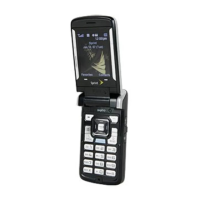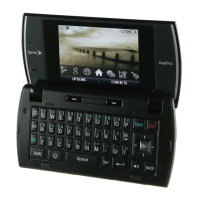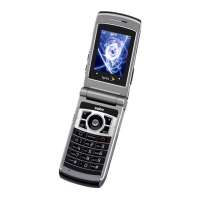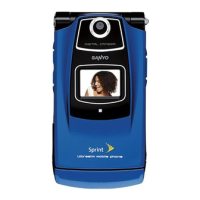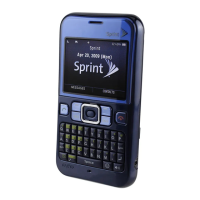
Do you have a question about the Sanyo Sprint KATANA and is the answer not in the manual?
| Network Technology | CDMA / EvDO |
|---|---|
| Display Type | TFT, 256K colors |
| Ringtones Type | Polyphonic, MP3 |
| Vibration | Yes |
| Camera | 1.3 MP |
| Browser | WAP 2.0/xHTML |
| Stand-by | Up to 200 h |
| Band | CDMA 800/1900 |
| Display Size | 2.2 inches |
| Resolution | 240 x 320 pixels |
| Messaging | SMS, MMS |
| Games | Yes |
| Java | Yes |
| Bluetooth | Yes |
Steps to set up and turn on your phone, set up voicemail, and establish passwords.
Guide to basic phone functions, features, and calling capabilities.
Explanation of the purpose and operation of each key on the phone.
Explanation of the status icons and symbols displayed on the phone's screen.
Steps to power the phone on and off.
Information on battery capacity, charging, and care.
Instructions for placing and receiving phone calls.
Methods for answering incoming calls, including when the phone is closed.
Procedure for making emergency calls, including 911.
Information on the phone's GPS feature for E911 location services.
Steps to save a phone number to the Contacts list from standby mode.
Customizing ringertypes, volume, and vibrate settings for calls and messages.
Assigning shortcuts to favorite functions for quick access.
Adjusting volume levels for ringers, earpiece, and applications.
Customizing screen backlight, screen saver, and animation.
How to enter the lock code to access the phone's security settings.
Locking the phone to receive only authorized calls and prevent unauthorized access.
Quickly deleting content like web cookies, history, cache, contacts, or downloaded items.
Restoring phone to factory defaults, including ringers and display settings.
Explanation of how roaming works and recognizing the roaming icon.
How to display lists of placed, accepted, and missed calls for easy redialing.
Steps to add a new contact with name, number, and number type.
Methods for displaying contacts by name, speed dial, or group.
Options for individual entries and groups, including editing, sending messages, and setting as secret.
Information on using the microSD card and adapter for memory expansion.
Managing files like pictures, videos, and music stored on the phone or microSD card.
Steps to connect the phone to a computer for data transfer using USB or Bluetooth.
Instructions for activating camera mode and taking pictures with the phone open or closed.
Configuring resolution, quality, shutter sound, status bar, and auto save settings.
Instructions for activating video mode, recording, and saving videos.
Managing photos and videos in My Albums, including In Phone and microSD folders.
Sending pictures and videos instantly to friends and family via Sprint Picture Mail.
Using the Sprint Picture Mail Web site to manage uploaded pictures and videos.
Printing pictures directly from the phone to a PictBridge-enabled printer.
Enabling or disabling the phone's Bluetooth feature for wireless connectivity.
Accessing Bluetooth functions like pairing, sending contacts, and printing.
Configuring Bluetooth name, visibility, device info, and trusted devices.
Establishing trusted connections between the phone and other Bluetooth devices.
Setting up, accessing, and managing voicemail messages and features.
Sending and receiving instant text messages, including preset messages.
Sending and receiving voice messages via SMS to phones or email addresses.
Overview of applications like Picture Mail, Messaging, Games, Ringers, Screen Savers, and Web.
Learning basics of Sprint Power Vision, including username, data connection, and web navigation.
Steps to initiate a Sprint Power Vision connection and access the home page.
Tips for navigating menus and Web sites using softkeys and scrolling.
Sending and receiving email, instant messages, and text messages.
Accessing and downloading premium services content like games, ringers, and screen savers.
Browsing Web sites using the phone's full-color graphic browser.
Using the phone's data connection as a modem for a laptop computer.
Installing software and connecting the phone to a computer for data services.
Accessing audio clips and video clips, including live TV and episodes.
Purchasing and downloading digital music files to play on the phone or computer.
Important operational and safety information for safe phone usage.
Guidelines for operating the phone properly and maintaining safe service.
Safety guidelines for phone usage, including emergency calls and driving.
Information on hearing aid compatibility and minimizing interference.
Guidelines for protecting the battery's performance and safety.
Understanding how the phone operates and safety standards for RF exposure.
Detailed terms of the limited warranty, including coverage, exclusions, and limitations.
